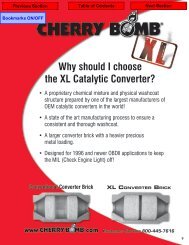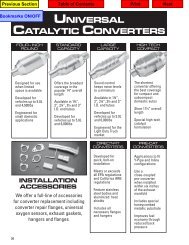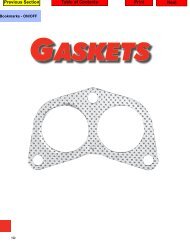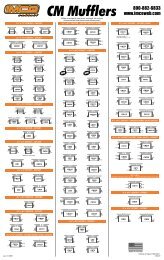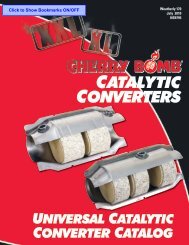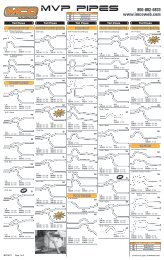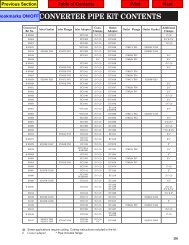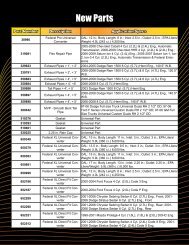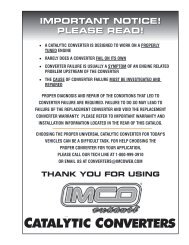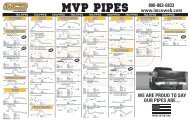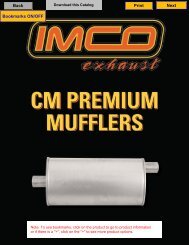California Catalytic Converter Applications - IMCO - International ...
California Catalytic Converter Applications - IMCO - International ...
California Catalytic Converter Applications - IMCO - International ...
You also want an ePaper? Increase the reach of your titles
YUMPU automatically turns print PDFs into web optimized ePapers that Google loves.
TABLE OF CONTENTS<br />
How To Use This Catalog........................................................................................................... 2<br />
Vehicle Application Index........................................................................................................... 3<br />
<strong>Converter</strong> Failure....................................................................................................................... 4<br />
What is OBDII.......................................................................................................................... 7<br />
How to Replace an OBDII <strong>Converter</strong>......................................................................................... 8<br />
Typical <strong>California</strong> OBDII Questions............................................................................................ 9<br />
New <strong>California</strong> Regulations Requirements.............................................................................. 11<br />
<strong>California</strong> OBDII <strong>Converter</strong> Warranty....................................................................................... 12<br />
OBDII Truck Application........................................................................................................... 13<br />
OBDII Numerical Listing........................................................................................................... 22<br />
1
HOW TO USE THIS CATALOG<br />
<strong>Applications</strong> are listed by:<br />
1. Make and Model: <strong>Applications</strong> are listed alphabetically, passenger cars first, followed by trucks.<br />
2. Vehicle Model Year: Most recent to earliest. Model year may be determined from<br />
Vehicle Identification Number<br />
3. Engine: Displacement (engine size) is shown in Liters<br />
4. Number of cylinders: Smallest to largest<br />
5. Emission Certification Level: Determines the groups of efficiencies that the vehicle emissions are<br />
categorized by. Used in conjunction with EFN to ensure proper application.<br />
6. Engine Family Number (EFN): EFN numbers must be determined in order to select the proper<br />
converter for the application. EFN data is listed on the vehicle underhood emissions decal.<br />
7. Sub-Model and Comments: This data further distinguishes an application. Items may be<br />
2 or 4 wheel drive, vehicle wheelbase, etc.<br />
8. Position: If the vehicle has more than one converter, the location is noted as Front, Rear, Driver’s Side,<br />
Passenger’s Side, Pre-<strong>Converter</strong>.<br />
9. Direct Fit <strong>Converter</strong>: <strong>Converter</strong> designed to fit like Original Equipment (OE) and requires little or no<br />
modification to the converter or mating parts.<br />
10. Universal <strong>Converter</strong>: <strong>Converter</strong> designed for the specific application that requires modification to<br />
mating parts for proper installation. NOTE: It is illegal to install a catalytic converter that is not<br />
approved for the specific vehicle application and it is illegal to select a catalytic converter for installation<br />
based solely on vehicle weight and engine size or based upon catalytic converter physical shape, size,<br />
configuration, or pipe diameters.<br />
2 3 4 5 6 7 8 9 10<br />
Year<br />
Engine<br />
(Liters) Cyl Cert EFN Sub-Model & Comments Position<br />
Direct Fit<br />
<strong>Converter</strong><br />
Universal<br />
<strong>Converter</strong><br />
1<br />
FORD E150 ECONOLINE<br />
2002 4.2 6 LEV 2FMXT04.2JF5 Direct Fit Replacement Drv. Side 655106<br />
2FMXT04.2JF5 Direct Fit Replacement Pass. Side 655107<br />
2FMXT04.2JF5 Individual Conv. Replacement RH/LH Front 655043<br />
2FMXT04.2JF5 Individual Conv. Replacement RH/LH Rear 655543<br />
2002 4.2 6 LEV 2FMXT04.2HF5 Direct Fit Replacement Drv. Side 655106<br />
2FMXT04.2HF5 Direct Fit Replacement Pass. Side 655107<br />
2
VEHICLE APPLICATION INDEX<br />
Ford E150 Econoline............................................................................................................... 13<br />
Ford E250 Econoline............................................................................................................... 14<br />
Ford E350 Econoline............................................................................................................... 15<br />
Ford Expedition........................................................................................................................ 15<br />
Ford Explorer........................................................................................................................... 16<br />
Ford F150................................................................................................................................ 16<br />
Ford F250................................................................................................................................ 19<br />
Lincoln Blackwood................................................................................................................... 20<br />
Lincoln Navigator..................................................................................................................... 20<br />
Mercury Mountaineer............................................................................................................... 21<br />
3
<strong>Converter</strong> Failure<br />
A converter has no moving parts and requires no service. Generally speaking, they do not<br />
fail on their own. Nonetheless, they do fail and the following conditions describe reasons for<br />
replacement.<br />
• The converter is missing<br />
• The wrong converter is on the vehicle<br />
• There is physical damage to the converter<br />
• The substrate inside the converter is broken or missing<br />
• The catalyst is poisoned form lead, oil, or anti-freeze<br />
• The substrate is plugged or melted<br />
• The converter does not pass emission tests<br />
Missing <strong>Converter</strong><br />
• <strong>California</strong> Vehicle Code Section 27156 prohibits removal of converters and replacing<br />
them with pipes, including “test pipes”. The vehicle owner and the shop installing the<br />
pipe are subject to fines.<br />
Wrong <strong>Converter</strong> Application<br />
• An aftermarket converter must be the same type as the original converter. Refer to<br />
the application guide or universal converter guide to determine the proper aftermarket<br />
converter for the application.<br />
• Replacement converters need to be installed in the same location as the original<br />
converter. The auto manufacturers locate the converters to optimize emission control<br />
system performance. In many cases the engine computer anticipates converter<br />
performance based upon the time it takes exhaust to travel to the converter. This is<br />
especially critical for OBDII.<br />
• The application guide for aftermarket converters and/or the Vehicle Emission Control<br />
Label may be used to determine correct application. It is the responsibility of the<br />
aftermarket converter manufacturer to properly list converters for vehicle applications.<br />
Physical Damage<br />
• There are holes or gashes in the converter shell or pipes welded to the converter.<br />
• There is rusting-out or exhaust leaks at seams, flanges, end tubes, or heat shields.<br />
• There is damage caused by an accident, driving over a road obstruction, or “off-road”<br />
use.<br />
• There is denting deep enough to break the ceramic substrate. Check for internal<br />
damage.<br />
4
Broken Monolithic Substrate<br />
• The monolithic substrate can be damaged by physical impact (see above), severe or<br />
prolonged engine backfire, or melt down due to failure of the engine fuel management<br />
system to properly control fuel-air ratios.<br />
• Broken substrates can plug the converter, or lodge in other converters, pipes, or<br />
mufflers downstream from the converter and cause excessive backpressure.<br />
• If the ceramic substrate within the converter is broken, it will generally rattle during a<br />
“thump test”.<br />
Substrate Poisoning (Chemical Damage)<br />
• Most fuels currently available in the United States and Canada are compatible with<br />
catalytic converters. However high levels of lead, phosphorus, or sulfur will poison or<br />
deactivate a catalytic converter.<br />
• Carbon soot from an engine running excessively “rich” fuel-air ratios can plug and<br />
deactivate a catalytic converter.<br />
• Excessive oil flow through the exhaust will plug and poison a catalytic converter. An<br />
engine “burning oil” due to worn piston rings/cylinder walls, worn valve guides, or failed<br />
turbo seals will cause damage to the catalytic converter. The partially burnt excess oil<br />
plugs the substrate. The phosphorus and sulfur in the oil poisons the catalyst.<br />
• Anti-freeze in the engine exhaust caused by engine mechanical problems coats the<br />
catalyst and prevents proper converter operation.<br />
• In general, converters that have been chemically damaged will not recover sufficient<br />
performance when the problem is corrected. Poisoned converters, in general, should<br />
be replaced. When in doubt perform an emissions test.<br />
Plugging/Meltdown<br />
• Characteristics of a plugged converter are increased exhaust restriction that reduce<br />
engine power, increase fuel consumption, and, in extreme cases, cause engine stalling.<br />
• Plugging can be caused by carbon, excessive unburned oil in the exhaust, anti-freeze in<br />
the exhaust, or broken converter substrates.<br />
• Meltdown is the physical melting of the substrate from excessive heat (Over 2500<br />
degrees Fahrenheit). Meltdown is caused by engine or supplementary air system<br />
malfunctions. Some of the contributing factors to meltdown are excessively “rich” fuelair<br />
ratios, failures of supplementary air in dual bed converters to turn off after warm-up<br />
or under certain load conditions, extended idle, excessive cranking, retarded ignition<br />
timing, or ignition misfire.<br />
5
• A backpressure test may be used to identify restrictions in the exhaust system.<br />
However, since substrate pieces could be lodged anywhere downstream in the exhaust<br />
system, all of the components that are plugged need to be replaced.<br />
• The converter body and heat shield provide evidence that indicate possible substrate<br />
meltdown. If either or both of the following are observed, examine the converter for<br />
possible substrate melting.<br />
– The heat shield has turned into a dull gray color. When the heat shield is heated<br />
over 1100 degrees the aluminized coating changes from a shiny to a dull gray.<br />
– The converter body appears to be distorted or has a warped appearance from<br />
being very hot. The stainless steel shells acquire a deep bluish tint when<br />
heated into the high red heat range. If the shell has an excessive amount of blue<br />
tint (especially around the substrates), it is likely that the substrate is melted.<br />
Failure to Meet Emissions Performance<br />
• <strong>Catalytic</strong> converters change exhaust gasses containing unburned hydrocarbons, carbon<br />
monoxide, and oxides of nitrogen into water, carbon dioxide, and nitrogen. When they<br />
fail to meet the government standards for emission performance, the catalytic converter<br />
should be replaced.<br />
• Poisoning, physical damage, and plugging will significantly degrade catalytic converter<br />
performance. In most cases poisoned, severely damaged, or plugged converters will<br />
need replacement.<br />
• <strong>Catalytic</strong> converter performance decreases over time due to a variety of factors. The<br />
catalyst undergoes “aging” - the accumulation of chemical and temperature incidents<br />
over time. Even well maintained and conservatively driven vehicles have reduced<br />
catalytic converter performance over time. Chemical and temperature factors over time<br />
cause irreversible physical and chemical changes to the catalyst on the surface of the<br />
substrate. These effects have been reduced by improvements in technology, but it is<br />
not likely they will be eliminated.<br />
• Many jurisdictions have in-use emission testing. Test failure indicates that the catalytic<br />
converter may need to be replaced. However, the catalytic converter is only one part<br />
of a complex system. Before replacing the converter make sure that the rest of the<br />
emission control system is functioning properly. For example a pass on HC and CO and<br />
failure of NOx might indicate a bad EGR system rather than a bad converter.<br />
• For OBDII equipped vehicles (generally 1996 and newer) the catalytic converter is<br />
monitored by the engine diagnostics. A fault code is set indicating that the converter<br />
may need to be replaced.<br />
6
WHAT IS OBD-II<br />
WHAT IS OBDII OBD-II<br />
OBD-II references the second generation of On Board Diagnostics used initially in <strong>California</strong><br />
OBDII and now references in all 50 states. the second It is a generation computerized of On engine Board and Diagnostics emission used monitoring initially system in <strong>California</strong> designed and<br />
to OBD-II alert the references driver that the emission second generation WHAT<br />
control service of On IS<br />
is Board OBD-II<br />
needed. Diagnostics used initially in <strong>California</strong><br />
now in all 50 states. It a computerized engine and emission monitoring system designed to<br />
and now in all 50 states. It is a computerized engine and emission monitoring system designed<br />
alert the driver that emission control service is needed.<br />
to OBD-II alert the references driver that the emission second generation control service of On is Board needed. Diagnostics used initially in <strong>California</strong><br />
What and now does in OBD all OBDII 50 monitor states. monitor It is a computerized engine and emission monitoring system designed<br />
to alert the driver that emission control service is needed. Other Sensors<br />
A<br />
OBD-II What does checks OBD the monitor operating conditions of:<br />
OBDII checks the operating conditions of:<br />
• <strong>Catalytic</strong> <strong>Converter</strong><br />
Other Sensors<br />
A<br />
OBD-II<br />
Engine OBDII<br />
Operation Diagnostics<br />
•<br />
What<br />
Oxygen<br />
does checks<br />
Sensors<br />
OBD the monitor operating conditions of:<br />
• <strong>Catalytic</strong> <strong>Converter</strong><br />
"Check<br />
• EGR <strong>Catalytic</strong> System<br />
Fuel Injectors<br />
• Oxygen<br />
<strong>Converter</strong><br />
Other Sensors<br />
A<br />
Engine OBDII<br />
OBD-II checks Sensors the operating conditions of:<br />
Engine"<br />
Operation Diagnostics<br />
• Evaporative Oxygen Emission Systems<br />
Light<br />
• EGR System<br />
Sensors<br />
Engine<br />
"Check<br />
• Ignition EGR <strong>Catalytic</strong> System<br />
• Evaporative & <strong>Converter</strong> Fuel Injection Systems<br />
Fuel Injectors<br />
Engine OBDII<br />
Emission Systems<br />
Engine"<br />
•<br />
Operation Diagnostics<br />
Engine Evaporative Oxygen<br />
• Ignition Misfire Sensors Emission Systems<br />
Light<br />
& Fuel Injection Systems<br />
Engine<br />
"Check<br />
• Ignition EGR System & Fuel Injection Systems<br />
Fuel Injectors<br />
Engine"<br />
• Engine Misfire<br />
How • Engine Evaporative does Misfire it work Emission Systems<br />
Light<br />
Engine<br />
• Ignition & Fuel Injection Systems<br />
When the OBD computer senses a problem in<br />
Oxygen<br />
Oxygen<br />
How • Engine does Misfire it it work<br />
Sensor<br />
Sensor<br />
one of the monitored systems, it turns on the<br />
Check When Engine OBDII light. Service senses technicians a problem<br />
How does the it work computer senses a problem can in<br />
Oxygen<br />
Oxygen<br />
Sensor<br />
Sensor<br />
in then one one of download the of the monitored monitored the computer systems, systems, codes it turns it with turns on a the scan on<br />
the tool. Check When MIL Computer the Engine (Malfunction OBD light. codes computer Service Indicator will tell senses technicians the Lamp technician a problem or “Check can in<br />
Oxygen<br />
Oxygen<br />
Other Sensors<br />
Sensor B<br />
Sensor<br />
Engine” what then one of download failed the light). monitored and, the Service in some computer systems, technicians cases, codes it also turns with can on a then<br />
scan<br />
download recommend tool. Check Computer Engine the repair. computer light. codes Service will codes tell technicians the with technician a scan can tool.<br />
Other Sensors<br />
Engine BOBDII<br />
Computer codes will tell the technician what<br />
Operation Diagnostics<br />
what then download failed and, the in some computer cases, codes also with a scan<br />
"Check<br />
failed What recommend tool. Computer vehicles and, in repair. some codes have cases, OBD-II will tell also the technician recommend<br />
Fuel Injectors<br />
Other Sensors<br />
Engine BOBDII<br />
Engine"<br />
Operation Diagnostics<br />
Light<br />
repair. what failed and, in some cases, also<br />
Engine<br />
"Check<br />
OBD-II What recommend vehicles first appeared repair. have OBD-II on some 1994 and 1995<br />
Fuel Injectors<br />
Engine OBDII<br />
Engine"<br />
models. It is now required on all vehicles<br />
Operation Monitored Diagnostics<br />
Unmonitored<br />
Light<br />
What vehicles have OBDII<br />
Engine<br />
starting OBD-II<br />
"Check<br />
What vehicles first with appeared the have 1996 OBD-II on model some year. 1994 and 1995<br />
Fuel Injectors<br />
Engine"<br />
Light<br />
OBDII models. first It is appeared now required on some on all 1994 vehicles<br />
Monitored<br />
Unmonitored<br />
and 1995<br />
Engine<br />
How to Identify an OBD-II equipped vehicle.<br />
Oxygen<br />
Oxygen<br />
models. starting OBD-II first with It is appeared the now 1996 required on model some year. on 1994 all and vehicles 1995<br />
Sensor<br />
Sensor<br />
Monitored<br />
Unmonitored<br />
starting models. with It is the now 1996 required model on year. all vehicles<br />
1) How starting The to emission with Identify the 1996 sticker an OBD-II model under equipped year. the hood vehicle.<br />
Oxygen<br />
Oxygen<br />
Sensor<br />
Sensor<br />
indicates the vehicle as "OBDII Certified" or<br />
How<br />
"OBDII 1) to<br />
Compliant".<br />
Identify an<br />
How The to emission Identify sticker OBD-II under equipped the hood vehicle.<br />
Oxygen<br />
Oxygen<br />
OBDII equipped vehicle:<br />
Sensor<br />
Sensor<br />
indicates the vehicle as "OBDII Certified" or<br />
Other Sensors C<br />
2) "OBDII 1)<br />
There<br />
The emission Compliant". is oxygen<br />
sticker<br />
sensor<br />
under<br />
downstream<br />
the hood<br />
from<br />
1) the The converter. emission See illustrations. sticker under In case the (A) hood<br />
indicates the vehicle as "OBDII Certified" or<br />
Other Sensors C<br />
indicates<br />
Engine OBDII<br />
there 2) There is one is the an converter vehicle oxygen as on sensor the “OBDII vehicle downstream Certified” and from or<br />
"OBDII Compliant".<br />
Operation Diagnostics<br />
“OBDII oxygen the converter. Compliant”. sensors See upstream illustrations. and downstream In case (A) from<br />
"Check<br />
Fuel Injectors Other Sensors<br />
Engine C OBDII<br />
there 2) There converter. is one is an converter oxygen Case (B) on sensor has the more vehicle downstream than and one from<br />
Engine"<br />
Operation Diagnostics<br />
Light<br />
2) converter oxygen the There converter. sensors with is an the See upstream oxygen added illustrations. sensor and downstream between In case (A) the from<br />
Engine<br />
"Check<br />
Fuel Injectors<br />
Engine OBDII Oxygen Sensor<br />
from front there converter. the and is one converter. rear converters. Case See (B) has illustrations. the The more vehicle front than converter and<br />
Engine"<br />
In one case is<br />
Operation Diagnostics (Placed between Light<br />
ceramics)<br />
(A) monitored converter oxygen there sensors is with by one the the upstream converter OBD-II added system sensor and on the downstream while between vehicle the the rear and from<br />
Engine<br />
"Check<br />
Fuel Injectors<br />
Oxygen Sensor<br />
oxygen converter front the converter. and sensors rear is unmonitored. converters. Case upstream (B) has The In and more case front downstream<br />
(C) than converter there one is is<br />
(Placed between<br />
Engine"<br />
ceramics)<br />
Light<br />
from an monitored converter oxygen the converter. with by sensor the OBD-II in added Case the (B) middle system sensor has of more while between the than converter the the one rear<br />
Engine<br />
Oxygen Sensor<br />
body. converter front and The rear with is OBD-II unmonitored. converters. the system added sensor monitors The In case front between (C) only converter there the front is is<br />
Oxygen<br />
(Placed between<br />
Sensor<br />
ceramics)<br />
front part an monitored oxygen of and the rear converter. by sensor the converters. OBD-II in the middle system The front of while the converter the rear<br />
is body. converter monitored The is OBD-II unmonitored. by the system OBDII monitors In system case (C) only while there the front is<br />
Oxygen<br />
Sensor<br />
rear part an oxygen of converter the converter. sensor is unmonitored.<br />
in the middle of In the case converter (C)<br />
there body. is The an oxygen OBD-II system sensor monitors in the middle only of the the front<br />
Oxygen<br />
Sensor<br />
converter part of the body. converter. The OBDII system monitors<br />
only 4 the front part of the converter.<br />
4<br />
4<br />
7
8<br />
HOW TO REPLACE AN OBDII CONVERTER<br />
Step One – Diagnosis<br />
The converter rarely fails on its own: it is usually a symptom of some other problem<br />
with the engine and/or its’ control system(s). Connect the diagnostic scan tool. Read all<br />
fault and pending codes. It is important to make all of the indicated repairs. Failure to make<br />
a repair identified by a fault code could lead to early converter failure and be interpreted under<br />
warranty provisions as not properly maintaining the engine, voiding the converter warranty.<br />
Step Two – <strong>Converter</strong> Replacement<br />
Determine the proper converter from the application guide, including EFN number. An application<br />
must be listed in the application guide if the replacement converter is to be used. Each<br />
converter identified by the fault code as failed must be replaced. No multiple converter replacements<br />
by a single converter are allowed. The converter outlet must be installed in the original<br />
position and orientation. Oxygen sensors upstream and downstream from the converter must<br />
be in their original positions. The distance between the two oxygen sensors must be maintained<br />
to ensure proper signals to the On Board Diagnostic (OBDII) System. The installation<br />
must be leak free since leaks can give false readings to the oxygen sensors. Failure to properly<br />
install an OBDII converter can lead to false OBDII failure codes.<br />
Note: There are some applications with converters downstream from the controlled converters.<br />
Such converters do not have an oxygen sensor downstream from the converter. These converters<br />
are unmonitored. In <strong>California</strong> they must be replaced with a <strong>California</strong> approved OBDII<br />
converter, even though they are not monitored by the OBDII system.<br />
Step Three – Reset Fault Codes and Road Test<br />
Use the scan tool or reset procedures established by the vehicle manufacturer to reset the<br />
fault codes. Manufacturer reset procedures may be listed in the owner’s manual, provided by<br />
general repair manuals, or obtained by calling the auto dealer. Road test the vehicle to confirm<br />
that no additional problems exist.<br />
• The test requires the engine to be cool. Generally this means coolant temperatures<br />
within 10-15 degrees of room temperature. Performing the test with a warm engine<br />
does not allow the diagnostic system to properly evaluate the converter or<br />
determine whether the oxygen sensors or other emissions components are within<br />
proper operational limits.<br />
• Idle in park or neutral for 3-4 minutes with the engine loaded by turning the air<br />
conditioner and/or defrosters on. This allows for diagnostic evaluations of the oxygen<br />
sensor warm-up and related items.<br />
• Turn off AC/defroster. Accelerate to 30 mph and maintain speed for 3-4 minutes.<br />
• Accelerate to 55 mph and maintain for 3-4 minutes.<br />
• Coast down to idle in gear. Try to avoid using the brakes until engine idle speed<br />
is reached.<br />
• Maintain idle in park or neutral for 3-4 minutes.<br />
• Check fault codes and pending codes.<br />
By testing after the converter is replaced, the test reveals whether other factors such as weak<br />
oxygen sensors need replacement or repair to prevent what might be a false indication of early<br />
converter failure. Failure to make necessary repairs could contribute to early converter failure<br />
and be interpreted under warranty provisions as not properly maintaining the engine.
TYPICAL CALIFORNIA OBDII QUESTIONS<br />
Q: How do I know when a converter needs replacement<br />
A: The check engine light identifies a malfunction. Running a diagnostic identifies the cause<br />
of the malfunction. TYPICAL If the fault CALIFORNIA codes indicate a OBD-II converter QUESTIONS<br />
malfunction, the converter may<br />
need to be replaced. Under the <strong>California</strong> OBDII rules, the OE converter can be replaced<br />
Q: with How a do New I know Aftermarket when a converter <strong>Converter</strong> needs that meets replacement <strong>California</strong> OBDII rules when the OE<br />
warranty has expired (generally 7 years or 70,000 miles).<br />
A: The check engine light identifies a malfunction. Running a diagnostic identifies the cause of the<br />
Q: I malfunction. replaced the If the defective fault codes converter indicate a but converter the check malfunction, engine the light converter still indicates should be a replaced. mal<br />
function. Under the Interim What’s <strong>California</strong> wrong OBD-II rules, the OE converter can be replaced with a New<br />
A: When Aftermarket the converter <strong>Converter</strong> is that replaced meets Interim the fault <strong>California</strong> codes must OBD-II be rules reset when following the OE the warranty vehicle has<br />
expired (generally 8 years or 80,000 miles).<br />
manufacturer specifications. If this is not done, the computer remembers earlier failures<br />
Q:<br />
and<br />
I replaced<br />
may give<br />
the<br />
a<br />
defective<br />
false reading<br />
converter<br />
that<br />
but<br />
the new<br />
the check<br />
converter<br />
engine<br />
is defective.<br />
light still indicates a malfunction.<br />
What’s wrong<br />
Q: Why do we need to be concerned about Tier 1, LEV, TLEV, and ULEV OBDII<br />
A: certifications<br />
When the converter is replaced the fault codes must be reset following the vehicle manufacturer<br />
A: Without specifications. an application If this is not guide done, to the use, computer the many remembers levels of earlier OBDII failures in <strong>California</strong> and may would give be a false too<br />
complex reading that and the confusing. new converter The most is defective. direct way to determine Tier 1, LEV, TLEV, and ULEV<br />
applications is to determine the Emission Family Number (EFN) sometimes also referred<br />
Q:Why do we need to be concerned about Tier 1, LEV, TLEV, and ULEV OBD-II certifications<br />
to as Emissions Family Code (EFC). There is a direct relationship between the EFN and<br />
A: the Without type an of application OBDII certification. guide to use, Therefore the many you levels must of use OBD-II the in application <strong>California</strong> would guide be to too determine<br />
the complex correct and converter confusing. for The the most application. direct way to determine Tier 1, LEV, TLEV, and ULEV<br />
applications is to determine the Emission Family Number (EFN) sometimes also referred to as<br />
Q: Is Emissions that why Family the EFN’s Code (EFC). are listed There in is the a direct application relationship guide between the EFN and the type of<br />
A: Yes. OBD-II By certification. listing the EFN Therefore numbers you must we make use the it easier application for the guide installer to determine to determine the correct the<br />
correct<br />
converter<br />
converter<br />
for the application.<br />
for the application.<br />
Q: Is that why the EFN’s are listed in the application guide<br />
Q: Where do I find the EFN number<br />
A: A: There Yes. By is listing no fixed the location, EFN numbers but typically we make the it easier EFN can for the be installer found on to determine a label attached the correct to the<br />
firewall, converter radiator for the application. support or hood.<br />
Q: Where do I find the EFN number<br />
A: There is no fixed location, but typically the EFN can be found on a label attached to the firewall,<br />
radiator support or hood.<br />
Here is an emission label example.<br />
The vehicle is identified as meeting<br />
1999 Federal NLEV standards and<br />
1999 <strong>California</strong> LEV standards. The<br />
EFN number is shaded for clarity and is<br />
located next to the “OBDII CERTIFIED”<br />
statement.<br />
9
TYPICAL CALIFORNIA<br />
OBD-II<br />
OBDII<br />
QUESTIONS<br />
QUESTIONS<br />
– Cont.<br />
- Cont.<br />
Here Here is a is second a second example. example. The tag The tag<br />
identifies identifies the vehicle the vehicle as a 1997 as a and 1997 and<br />
OBD-II Certified as a TLEV vehicle. The<br />
OBDII Certified as a TLEV vehicle.<br />
EFN number is identified as the “Engine<br />
Family”.<br />
The EFN<br />
We bolded<br />
number<br />
the<br />
is<br />
EFN<br />
identified<br />
number<br />
as<br />
for emphasis. the “Engine Family”. We bolded<br />
the EFN number for emphasis.<br />
<br />
Q: Q: Why What a Consolidated if I want to <strong>Converter</strong> use install rather a Universal than a Universal <strong>Converter</strong> <strong>Converter</strong><br />
A: The new <strong>California</strong> OBDII regulations require the installer to use the application guide as<br />
A: The the new only <strong>California</strong> source Interim to determine OBD-II regulations the correct require converter the installer for an application. to use the application One reason guide for as this<br />
the only rule source is that there to determine may be the multiple correct OE converter certifications for an application. for an application One reason and for the this new rule after is<br />
that market there may replacement be multiple converter OE certifications may not for meet an application all of the and OE the certifications. new aftermarket If an application<br />
replacement<br />
is not listed<br />
converter<br />
in the<br />
may<br />
application<br />
not meet<br />
guide<br />
all of<br />
then OE<br />
a universal<br />
certifications.<br />
converter<br />
If an application<br />
cannot be<br />
is<br />
used.<br />
not listed in<br />
the application guide then a consolidated converter cannot be used.<br />
Q: Q: The The downstream downstream converter converter my on application my application isn’t monitored. isn’t monitored. Do I need Do to I use need a to use a<br />
<strong>California</strong> <strong>California</strong> OBD-II OBDII converter converter for the for application the application<br />
A: The fact that a rear converter lacks a sensor downstream and therefore isn’t monitored<br />
A: The doesn’t fact that change a rear converter the installation lacks a sensor requirements. downstream Emissions and therefore certifications isn’t monitored are for doesn’t a complete<br />
change system. the installation When multiple requirements. converters Emissions are present certifications they must are all for meet a complete the <strong>California</strong> system. When OBDII<br />
multiple regulations. converters are present they must all meet the <strong>California</strong> OBD-II regulations.<br />
Q: There are two converters, front and rear, in my application. Is this a split converter<br />
Q: application There are that two I can converters, replace with front a single and converter rear, in my application. Is this a split converter<br />
application that I can replace with a single converter<br />
A: A: <strong>California</strong> <strong>California</strong> requires requires that the that replacement the replacement converter converter system must system have must the same have number the same of number of<br />
converters as the as OE the system OE system and the and replacement the replacement converters converters must be in must the same be in locations. the same<br />
locations.<br />
Q: How has the warranty changed<br />
Q: How has the warranty changed<br />
A: <strong>Converter</strong>s developed to meet Interim <strong>California</strong> OBD-II regulations are designed for a longer life.<br />
A: At 50,000 <strong>Converter</strong>s miles they developed must meet to meet OE performance <strong>California</strong> OBDII at useful regulations life (100,000 are – 120,000 designed miles). for a longer life.<br />
At 5 years or 50,000 miles they must meet OE performance at useful life (100,000 –<br />
Q: I want 120,000 to use miles). a better converter. Can these <strong>California</strong> OBD-II <strong>Converter</strong>s be used outside<br />
<strong>California</strong><br />
Q: I want to use a better converter. Can these <strong>California</strong> OBDII <strong>Converter</strong>s be used<br />
A: At present outside the <strong>California</strong><br />
Federal EPA has not ruled on this question. The testing to meet <strong>California</strong> Interim<br />
Rules is different than the Federal Test Procedure and therefore converters developed for<br />
A: At present, the Federal EPA has not ruled on this question. The testing to meet <strong>California</strong><br />
<strong>California</strong> do not meet the exact Federal requirements. Unlike most other aftermarket converter<br />
companies,<br />
Rules is<br />
we<br />
different<br />
have been<br />
than<br />
developing<br />
the Federal<br />
catalysts<br />
Test Procedure<br />
for the aftermarket<br />
and therefore<br />
since 1980.<br />
converters<br />
We have<br />
developed<br />
also<br />
for<br />
been <strong>California</strong> involved in do the not development meet the exact of OE Federal converters requirements. since 1972. Unlike Based most upon this other extensive aftermarket<br />
experience converter we companies, believe that the we converters have been developed developing to meet catalysts <strong>California</strong> the Interim aftermarket OBD-II since 1980.<br />
applications We have have also superior been involved emissions in performance the development when of compared OE converters with converters since 1972. certified Based to<br />
meet upon current this Federal extensive aftermarket experience requirements. we believe Operating that the life converters for example developed is twice as to long meet for<br />
the Interim <strong>California</strong> <strong>California</strong> OBDII converters applications as compared have superior with Federal emissions aftermarket performance converters. when compared with<br />
converters certified to meet current Federal aftermarket requirements. Operating life 7for<br />
example is twice as long for the <strong>California</strong> converters as compared with Federal<br />
10 aftermarket converters.
CALIFORNIA AIR RESOURCES BOARD<br />
<strong>California</strong> OBDII catalytic converters are environmentally friendly replacement converters<br />
engineered to meet the more exacting performance and durability requirements of the<br />
<strong>California</strong> Air Resources Board for OBDII <strong>Converter</strong>s. These <strong>California</strong> catalytic converters<br />
have a higher performance and a longer warranty period than conventional new aftermarket<br />
replacement catalytic converters. <strong>California</strong> Air Resources catalytic converters may be used<br />
only for the specific vehicle applications evaluated in the compliance process. They are not<br />
universal converters and may not be used for an application unless that application is listed<br />
in the <strong>California</strong> application guide.<br />
NEW CALIFORNIA REGULATIONS REQUIRE<br />
● <strong>California</strong> emissions performance warranty coverage for 5 years or<br />
50,000 miles.<br />
● No catalyst–related MIL (Malfunction Indicator Lamp or “check engine<br />
light”) for 5 years or 50,000 miles after installation. (After installation<br />
of the replacement converter the OBDII diagnostics must be cleared<br />
to ensure that the MIL light does not immediately reoccur.)<br />
● <strong>Converter</strong>s can ONLY be installed for applications specifically listed<br />
in the application guide.<br />
● The aftermarket converter and oxygen sensor must be placed in the<br />
same locations as the original converter and sensor.<br />
● Only defective converters that are no longer covered by original<br />
vehicle warranties may be replaced (generally after 7 years or 70,000<br />
miles).<br />
● All required converters (including original converters that were<br />
not replaced) must remain in the exhaust system. Elimination or<br />
combinations of converters into a single replacement converter is not<br />
permitted.<br />
● Warranty card must be completed by the installer, signed by the<br />
customer, attached to the repair invoice, and a copy returned to the<br />
manufacturer.<br />
● Installers are required to keep documentation regarding the installation<br />
of new aftermarket catalytic converters on file for four (4) years from<br />
date of installation.<br />
11
WHAT YOU SHOULD KNOW ABOUT<br />
OUR CALIFORNIA CONVERTER WARRANTY<br />
Our converters are designed and tested to meet all <strong>California</strong> warranty provisions. We therefore<br />
warrant our <strong>California</strong> converters to meet <strong>California</strong> Air Resources Board emission requirements<br />
for five years or 50,000 miles, whichever occurs first. The converter external shells, including<br />
end pipes are warranted for five years or 50,000 miles from the date of installation. We further<br />
state that our converters when properly installed on vehicles that are properly maintained will<br />
not result in any unsafe condition to the vehicle, its occupants, or others in close proximity to the<br />
vehicle. For this warranty to be effective the warranty card must be properly filled out with copies<br />
provided to the vehicle owner and converter manufacturer.<br />
Some conditions that could void this warranty include:<br />
● Use of leaded gas in the vehicle. Even a small amount of lead will coat the catalyst<br />
and prevent proper operation.<br />
● Improperly tuned or maintained engine. Misfiring spark plugs, improper fuel mixture,<br />
or improper engine adjustments and modifications can cause high levels of unburned<br />
fuel to reach the converter and damage it. Excessive oil, that passes through the rings<br />
or valves and enters the exhaust system, can also damage the converter.<br />
● Not replacing or using a defective converter in front of the converter that is being<br />
replaced. On a multiple converter system, broken substrate from the first converter<br />
may enter the second converter and damage its substrate. The second converter is<br />
not warranted under these conditions<br />
12
Year<br />
CALIFORNIA OBDII TRUCK APPLICATION GUIDE<br />
Engine<br />
(Liters) Cyl Cert EFN Sub-Model & Comments Position Direct Fit Universal<br />
FORD E150 ECONOLINE<br />
2002 4.2 6 LEV 2FMXT04.2JF5 Direct Fit Replacement Drv. Side 655106<br />
2FMXT04.2JF5 Direct Fit Replacement Pass. Side 655107<br />
2FMXT04.2JF5 Individual Conv. Replacement RH/LH Front 655043<br />
2FMXT04.2JF5 Individual Conv. Replacement RH/LH Rear 655543<br />
2002 4.2 6 LEV 2FMXT04.2HF5 Direct Fit Replacement Drv. Side 655106<br />
2FMXT04.2HF5 Direct Fit Replacement Pass. Side 655107<br />
2FMXT04.2HF5 Individual Conv. Replacement RH/LH Front 655043<br />
2FMXT04.2HF5 Individual Conv. Replacement RH/LH Rear 655543<br />
2001 4.2 6 LEV 1FMXT04.2JG5 Direct Fit Replacement Drv. Side 655106<br />
1FMXT04.2JG5 Direct Fit Replacement Pass. Side 655107<br />
1FMXT04.2JG5 Individual Conv. Replacement RH/LH Front 655043<br />
1FMXT04.2JG5 Individual Conv. Replacement RH/LH Rear 655543<br />
2001 4.2 6 LEV 1FMXT04.2HG5 Direct Fit Replacement Drv. Side 655106<br />
1FMXT04.2HG5 Direct Fit Replacement Pass. Side 655107<br />
1FMXT04.2HG5 Individual Conv. Replacement RH/LH Front 655043<br />
1FMXT04.2HG5 Individual Conv. Replacement RH/LH Rear 655543<br />
2000 4.2 6 LEV YFMXA04.2JGC Direct Fit Replacement Drv. Side 655106<br />
YFMXA04.2JGC Direct Fit Replacement Pass. Side 655107<br />
YFMXA04.2JGC Individual Conv. Replacement RH/LH Front 655043<br />
YFMXA04.2JGC Individual Conv. Replacement RH/LH Rear 655543<br />
2000 4.2 6 LEV YFMXT04.2HGC Direct Fit Replacement Drv. Side 655106<br />
YFMXT04.2HGC Direct Fit Replacement Pass. Side 655107<br />
YFMXT04.2HGC Individual Conv. Replacement RH/LH Front 655043<br />
YFMXT04.2HGC Individual Conv. Replacement RH/LH Rear 655543<br />
1999 4.2 6 LEV XFMXA04.2HGC Direct Fit Replacement Drv. Side 655106<br />
XFMXA04.2HGC Direct Fit Replacement Pass. Side 655107<br />
XFMXA04.2HGC Individual Conv. Replacement RH/LH Front 655043<br />
XFMXA04.2HGC Individual Conv. Replacement RH/LH Rear 655543<br />
1999 4.2 6 LEV XFMXA04.2JGC Direct Fit Replacement Drv. Side 655106<br />
XFMXA04.2JGC Direct Fit Replacement Pass. Side 655107<br />
XFMXA04.2JGC Individual Conv. Replacement RH/LH Front 655043<br />
XFMXA04.2JGC Individual Conv. Replacement RH/LH Rear 655543<br />
1998 4.2 6 Tier 1 WFMXA04.2AAA Direct Fit Replacement Drv. Side 655106<br />
WFMXA04.2AAA Direct Fit Replacement Pass. Side 655107<br />
WFMXA04.2AAA Individual Conv. Replacement RH/LH Front 655043<br />
WFMXA04.2AAA Individual Conv. Replacement RH/LH Rear 655543<br />
13
Year<br />
CALIFORNIA OBDII TRUCK APPLICATION GUIDE<br />
Engine<br />
(Liters) Cyl Cert EFN Sub-Model & Comments Position Direct Fit Universal<br />
FORD E150 ECONOLINE (cont.)<br />
1998 4.2 6 Tier 1 WFMXA04.2ABA Direct Fit Replacement Drv. Side 655106<br />
WFMXA04.2ABA Direct Fit Replacement Pass. Side 655107<br />
WFMXA04.2ABA Individual Conv. Replacement RH/LH Front 655043<br />
WFMXA04.2ABA Individual Conv. Replacement RH/LH Rear 655543<br />
1997 4.2 6 Tier 1 VFM4.2H8G1EK Direct Fit Replacement Drv. Side 655106<br />
VFM4.2H8G1EK Direct Fit Replacement Pass. Side 655107<br />
VFM4.2H8G1EK Individual Conv. Replacement RH/LH Front 655043<br />
VFM4.2H8G1EK Individual Conv. Replacement RH/LH Rear 655543<br />
1997 4.2 6 Tier 1 VFM4.2J8G1EK Direct Fit Replacement Drv. Side 655106<br />
VFM4.2J8G1EK Direct Fit Replacement Pass. Side 655107<br />
VFM4.2J8G1EK Individual Conv. Replacement RH/LH Front 655043<br />
VFM4.2J8G1EK Individual Conv. Replacement RH/LH Rear 655543<br />
2001 4.6 8 LEV 1FMXT04.6JF5 Individual Conv. Replacement RH/LH Front 655043<br />
1FMXT04.6JF5 Individual Conv. Replacement RH/LH Rear 655543<br />
2001 5.4 8 LEV 1FMXT05.4RF7 Individual Conv. Replacement RH/LH Front 655043<br />
1FMXT05.4RF7 Individual Conv. Replacement RH/LH Rear 655543<br />
2000 4.6 8 LEV YFMXA04.66FF Individual Conv. Replacement RH/LH Front 655043<br />
YFMXA04.66FF Individual Conv. Replacement RH/LH Rear 655543<br />
2000 5.4 8 LEV YFMXA05.4RF7 Individual Conv. Replacement RH/LH Front 655043<br />
YFMXA05.4RF7 Individual Conv. Replacement RH/LH Rear 655543<br />
1999 4.6 8 Tier 1 XFMXA04.6JBC Individual Conv. Replacement RH/LH Front 655043<br />
XFMXA04.6JBC Individual Conv. Replacement RH/LH Rear 655543<br />
1997 4.6 8 Tier 1 VFM4.6J8G1EK Individual Conv. Replacement RH/LH Front 655043<br />
FORD E250 ECONOLINE<br />
VFM4.6J8G1EK Individual Conv. Replacement RH/LH Rear 655543<br />
2002 4.2 6 LEV 2FMXT04.2JF5 Direct Fit Replacement Drv. Side 655106<br />
2FMXT04.2JF5 Direct Fit Replacement Pass. Side 655107<br />
2FMXT04.2JF5 Individual Conv. Replacement RH/LH Front 655043<br />
2FMXT04.2JF5 Individual Conv. Replacement RH/LH Rear 655543<br />
2001 4.2 6 LEV 1FMXT04.2JG5 Direct Fit Replacement Drv. Side 655106<br />
1FMXT04.2JG5 Direct Fit Replacement Pass. Side 655107<br />
1FMXT04.2JG5 Individual Conv. Replacement RH/LH Front 655043<br />
1FMXT04.2JG5 Individual Conv. Replacement RH/LH Rear 655543<br />
2000 4.2 6 LEV YFMXA04.2JGC Direct Fit Replacement Drv. Side 655106<br />
YFMXA04.2JGC Direct Fit Replacement Pass. Side 655107<br />
YFMXA04.2JGC Individual Conv. Replacement RH/LH Front 655043<br />
YFMXA04.2JGC Individual Conv. Replacement RH/LH Rear 655543<br />
14
Year<br />
CALIFORNIA OBDII TRUCK APPLICATION GUIDE<br />
Engine<br />
(Liters) Cyl Cert EFN Sub-Model & Comments Position Direct Fit Universal<br />
FORD E250 ECONOLINE (cont.)<br />
1999 4.2 6 LEV XFMXA04.2JGC Direct Fit Replacement Drv. Side 655106<br />
XFMXA04.2JGC Direct Fit Replacement Pass. Side 655107<br />
XFMXA04.2JGC Individual Conv. Replacement RH/LH Front 655043<br />
XFMXA04.2JGC Individual Conv. Replacement RH/LH Rear 655543<br />
1998 4.2 6 Tier 1 WFMXA04.2ABA Direct Fit Replacement Drv. Side 655106<br />
WFMXA04.2ABA Direct Fit Replacement Pass. Side 655107<br />
WFMXA04.2ABA Individual Conv. Replacement RH/LH Front 655043<br />
WFMXA04.2ABA Individual Conv. Replacement RH/LH Rear 655543<br />
1997 4.2 6 Tier 1 VFM4.2J8G1EK Direct Fit Replacement Drv. Side 655106<br />
VFM4.2J8G1EK Direct Fit Replacement Pass. Side 655107<br />
VFM4.2J8G1EK Individual Conv. Replacement RH/LH Front 655043<br />
VFM4.2J8G1EK Individual Conv. Replacement RH/LH Rear 655543<br />
2001 5.4 8 LEV 1FMXT05.4RF7 Individual Conv. Replacement RH/LH Front 655043<br />
1FMXT05.4RF7 Individual Conv. Replacement RH/LH Rear 655543<br />
2000 5.4 8 LEV YFMXA05.4RF7 Individual Conv. Replacement RH/LH Front 655043<br />
YFMXA05.4RF7 Individual Conv. Replacement RH/LH Rear 655543<br />
1997 4.6 8 Tier 1 VFM4.6J8G1EK Individual Conv. Replacement RH/LH Front 655043<br />
FORD E350 ECONOLINE<br />
VFM4.6J8G1EK Individual Conv. Replacement RH/LH Rear 655543<br />
2001 5.4 8 LEV 1FMXT05.4RF7 Individual Conv. Replacement RH/LH Front 655043<br />
1FMXT05.4RF7 Individual Conv. Replacement RH/LH Rear 655543<br />
2000 5.4 8 LEV YFMXA05.4RF7 Individual Conv. Replacement RH/LH Front 655043<br />
FORD EXPEDITION<br />
YFMXA05.4RF7 Individual Conv. Replacement RH/LH Rear 655543<br />
2002 5.4 8 LEV 2FMXT05.4RF8 Individual Conv. Replacement RH/LH Front 655043<br />
2FMXT05.4RF8 Individual Conv. Replacement RH/LH Rear 655543<br />
2001 4.6 8 LEV 1FMXT04.66F5 Individual Conv. Replacement RH/LH Front 655043<br />
1FMXT04.66F5 Individual Conv. Replacement RH/LH Rear 655543<br />
2001 4.6 8 LEV 1FMXT04.66F7 Individual Conv. Replacement RH/LH Front 655043<br />
1FMXT04.66F7 Individual Conv. Replacement RH/LH Rear 655543<br />
2001 5.4 8 LEV 1FMXT05.4RF7 Individual Conv. Replacement RH/LH Front 655043<br />
1FMXT05.4RF7 Individual Conv. Replacement RH/LH Rear 655543<br />
2001 5.4 8 LEV 1FMXT05.4RF8 Individual Conv. Replacement RH/LH Front 655043<br />
1FMXT05.4RF8 Individual Conv. Replacement RH/LH Rear 655543<br />
2000 5.4 8 LEV YFMXA05.4RF7 Individual Conv. Replacement RH/LH Front 655043<br />
YFMXA05.4RF7 Individual Conv. Replacement RH/LH Rear 655543<br />
15
16<br />
Year<br />
CALIFORNIA OBDII TRUCK APPLICATION GUIDE<br />
Engine<br />
(Liters) Cyl Cert EFN Sub-Model & Comments Position Direct Fit Universal<br />
FORD EXPEDITION (cont.)<br />
1999 5.4 8 LEV XFMXA05.4JGC Individual Conv. Replacement RH/LH Front 655043<br />
XFMXA05.4JGC Individual Conv. Replacement RH/LH Rear 655543<br />
WFMXA05.4JGC Individual Conv. Replacement RH/LH Front 655043<br />
WFMXA05.4JGC Individual Conv. Replacement RH/LH Rear 655543<br />
1997 4.6 8 Tier 1 VFM4.6J8G1EK 2WD Drv. Side 655113<br />
VFM4.6J8G1EK 2WD Pass. Side 655112<br />
VFM4.6J8G1EK 4WD Drv. Side 655103<br />
VFM4.6J8G1EK 4WD Pass. Side 655102<br />
VFM4.6J8G1EK Individual Conv. Replacement RH/LH Front 655043<br />
VFM4.6J8G1EK Individual Conv. Replacement RH/LH Rear 655543<br />
1997 5.4 8 Tier 1 VFM5.4J8G1FK Individual Conv. Replacement RH/LH Front 655043<br />
FORD EXPLORER<br />
VFM5.4J8G1FK Individual Conv. Replacement RH/LH Rear 655543<br />
2001 5.0 8 LEV 1FMXT05.02F5 Direct Fit Replacement Drv. Side 655098<br />
1FMXT05.02F5 Direct Fit Replacement Pass. Side 655097<br />
1FMXT05.02F5 Individual Conv. Replacement RH/LH Front 655083<br />
1FMXT05.02F5 Individual Conv. Replacement RH/LH Rear 655503<br />
2000 5.0 8 LEV YFMXT05.02F5 Direct Fit Replacement Drv. Side 655098<br />
YFMXT05.02F5 Direct Fit Replacement Pass. Side 655097<br />
YFMXT05.02F5 Individual Conv. Replacement RH/LH Front 655083<br />
YFMXT05.02F5 Individual Conv. Replacement RH/LH Rear 655503<br />
1999 5.0 8 LEV XFMXT05.02GF From 4/22/98<br />
1998 5.0 8 TLEV WFMXT05.02DC To 4/21/98<br />
XFMXT05.02GF Direct Fit Replacement Drv. Side 655098<br />
XFMXT05.02GF Direct Fit Replacement Pass. Side 655097<br />
XFMXT05.02GF Individual Conv. Replacement RH/LH Front 655083<br />
XFMXT05.02GF Individual Conv. Replacement RH/LH Rear 655503<br />
WFMXT05.02DC Front <strong>Converter</strong> Drv. Side 655099 655083<br />
WFMXT05.02DC Front <strong>Converter</strong> Pass. Side 655100 655083<br />
WFMXT05.02DC Rear <strong>Converter</strong> RH/LH 655114 655503<br />
1997 5.0 8 Tier 1 VFM5.028GFEK Front <strong>Converter</strong> Drv. Side 655099 655083<br />
VFM5.028GFEK Front <strong>Converter</strong> Pass. Side 655100 655083<br />
VFM5.028GFEK Rear <strong>Converter</strong> RH/LH 655114 655503<br />
1996 5.0 8 Tier 1 TFM5.028GFEK Front <strong>Converter</strong> Drv. Side 655099 655083<br />
FORD F150 PICKUP<br />
TFM5.028GFEK Front <strong>Converter</strong> Pass. Side 655100 655083<br />
TFM5.028GFEK Rear <strong>Converter</strong> RH/LH 655114 655503<br />
2001 4.2 6 LEV 1FMXT04.22F5 Individual Conv. Replacement RH/LH Front 655043<br />
1FMXT04.22F5 Individual Conv. Replacement RH/LH Rear 655543
Year<br />
CALIFORNIA OBDII TRUCK APPLICATION GUIDE<br />
Engine<br />
(Liters) Cyl Cert EFN Sub-Model & Comments Position Direct Fit Universal<br />
FORD F150 PICKUP (cont.)<br />
2000 4.2 6 LEV YFMXT04.22FC 2WD Drv. Side 655109<br />
YFMXT04.22FC 2WD Pass. Side 655110<br />
YFMXT04.22FC 4WD Drv. Side<br />
YFMXT04.22FC 4WD Pass. Side<br />
YFMXT04.22FC Individual Conv. Replacement RH/LH Front 655043<br />
YFMXT04.22FC Individual Conv. Replacement RH/LH Rear 655543<br />
1999 4.2 6 LEV XFMXT04.22GC 2WD Drv. Side 655109<br />
XFMXT04.22GC 2WD Pass. Side 655110<br />
XFMXT04.22GC 4WD Drv. Side<br />
XFMXT04.22GC 4WD Pass. Side<br />
XFMXT04.22GC Individual Conv. Replacement RH/LH Front 655043<br />
XFMXT04.22GC Individual Conv. Replacement RH/LH Rear 655543<br />
1998 4.2 6 Tier 1 WFMXA04.2AAA 2WD Drv. Side 655109<br />
WFMXA04.2AAA 2WD Pass. Side 655110<br />
WFMXA04.2AAA 4WD Drv. Side<br />
WFMXA04.2AAA 4WD Pass. Side<br />
WFMXA04.2AAA Individual Conv. Replacement RH/LH Front 655043<br />
WFMXA04.2AAA Individual Conv. Replacement RH/LH Rear 655543<br />
1997 4.2 6 Tier 1 VFM4.228G1EK 2WD Drv. Side 655109<br />
VFM4.228G1EK 2WD Pass. Side 655110<br />
VFM4.228G1EK 4WD Drv. Side<br />
VFM4.228G1EK 4WD Pass. Side<br />
VFM4.228G1EK Individual Conv. Replacement RH/LH Front 655043<br />
VFM4.228G1EK Individual Conv. Replacement RH/LH Rear 655543<br />
2002 5.4 8 LEV 2FMXT05.42F5 Individual Conv. Replacement RH/LH Front 655043<br />
2FMXT05.42F5 Individual Conv. Replacement RH/LH Rear 655543<br />
2002 5.4 8 LEV 2FMXT05.4PF5 Individual Conv. Replacement RH/LH Front 655043<br />
2FMXT05.4PF5 Individual Conv. Replacement RH/LH Rear 655543<br />
2002 5.4 8 LEV 2FMXT05.4PF6 Individual Conv. Replacement RH/LH Front 655043<br />
2FMXT05.4PF6 Individual Conv. Replacement RH/LH Rear 655543<br />
2002 5.4 8 LEV 2FMXT05.4RF6 Individual Conv. Replacement RH/LH Front 655043<br />
2FMXT05.4RF6 Individual Conv. Replacement RH/LH Rear 655543<br />
2002 5.4 8 LEV 2FMXT05.4RF8 Individual Conv. Replacement RH/LH Front 655043<br />
2FMXT05.4RF8 Individual Conv. Replacement RH/LH Rear 655543<br />
2001 4.6 8 LEV 1FMXT04.6PF5 Individual Conv. Replacement RH/LH Front 655043<br />
1FMXT04.6PF5 Individual Conv. Replacement RH/LH Rear 655543<br />
2001 4.6 8 LEV 1FMXT04.6PF6 Individual Conv. Replacement RH/LH Front 655043<br />
1FMXT04.6PF6 Individual Conv. Replacement RH/LH Rear 655543<br />
17
18<br />
Year<br />
CALIFORNIA OBDII TRUCK APPLICATION GUIDE<br />
Engine<br />
(Liters) Cyl Cert EFN Sub-Model & Comments Position Direct Fit Universal<br />
FORD F150 PICKUP (cont.)<br />
2001 5.4 8 LEV 1FMXT05.42F5 Individual Conv. Replacement RH/LH Front 655043<br />
1FMXT05.42F5 Individual Conv. Replacement RH/LH Rear 655543<br />
2001 5.4 8 LEV 1FMXT05.4PF4 Individual Conv. Replacement RH/LH Front 655043<br />
1FMXT05.4PF4 Individual Conv. Replacement RH/LH Rear 655543<br />
2001 5.4 8 LEV 1FMXT05.4PF5 Individual Conv. Replacement RH/LH Front 655043<br />
1FMXT05.4PF5 Individual Conv. Replacement RH/LH Rear 655543<br />
2001 5.4 8 LEV 1FMXT05.4RF7 Individual Conv. Replacement RH/LH Front 655043<br />
1FMXT05.4RF7 Individual Conv. Replacement RH/LH Rear 655543<br />
2001 5.4 8 LEV 1FMXT05.4RF8 Individual Conv. Replacement RH/LH Front 655043<br />
1FMXT05.4RF8 Individual Conv. Replacement RH/LH Rear 655543<br />
2000 4.6 8 LEV YFMXA04.6HGC 2WD Drv. Side 655113<br />
YFMXA04.6HGC 2WD Pass. Side 655112<br />
YFMXA04.6HGC 4WD Drv. Side 655103<br />
YFMXA04.6HGC 4WD Pass. Side 655102<br />
YFMXA04.6HGC Individual Conv. Replacement RH/LH Front 655043<br />
YFMXA04.6HGC Individual Conv. Replacement RH/LH Rear 655543<br />
2000 5.4 8 LEV YFMXA05.4HGC Individual Conv. Replacement RH/LH Front 655043<br />
YFMXA05.4HGC Individual Conv. Replacement RH/LH Rear 655543<br />
2000 5.4 8 LEV YFMXA05.4RF7 Individual Conv. Replacement RH/LH Front 655043<br />
YFMXA05.4RF7 Individual Conv. Replacement RH/LH Rear 655543<br />
2000 5.4 8 LEV YFMXT05.4PF5 Individual Conv. Replacement RH/LH Front 655043<br />
YFMXT05.4PF5 Individual Conv. Replacement RH/LH Rear 655543<br />
1999 4.6 8 LEV XFMXA04.6HGC 2WD Drv. Side 655113<br />
XFMXA04.6HGC 2WD Pass. Side 655112<br />
XFMXA04.6HGC 4WD Drv. Side 655103<br />
XFMXA04.6HGC 4WD Pass. Side 655102<br />
XFMXA04.6HGC Individual Conv. Replacement RH/LH Front 655043<br />
XFMXA04.6HGC Individual Conv. Replacement RH/LH Rear 655543<br />
1999 5.4 8 LEV XFMXA05.4HGC Individual Conv. Replacement RH/LH Front 655043<br />
XFMXA05.4HGC Individual Conv. Replacement RH/LH Rear 655543<br />
1999 5.4 8 LEV XFMXA05.4JGC Individual Conv. Replacement RH/LH Front 655043<br />
XFMXA05.4JGC Individual Conv. Replacement RH/LH Rear 655543<br />
1998 4.6 8 Tier 1 WFMXA04.6AAA 2WD Drv. Side 655113<br />
WFMXA04.6AAA 2WD Pass. Side 655112<br />
WFMXA04.6AAA 4WD Drv. Side 655103<br />
WFMXA04.6AAA 4WD Pass. Side 655102<br />
WFMXA04.6AAA Individual Conv. Replacement RH/LH Front 655043<br />
WFMXA04.6AAA Individual Conv. Replacement RH/LH Rear 655543
Year<br />
CALIFORNIA OBDII TRUCK APPLICATION GUIDE<br />
Engine<br />
(Liters) Cyl Cert EFN Sub-Model & Comments Position Direct Fit Universal<br />
FORD F150 PICKUP (cont.)<br />
1998 4.6 8 Tier 1 WFMXA04.6BAA 2WD Drv. Side 655113<br />
WFMXA04.6BAA 2WD Pass. Side 655112<br />
WFMXA04.6BAA 4WD Drv. Side 655103<br />
WFMXA04.6BAA 4WD Pass. Side 655102<br />
WFMXA04.6BAA Individual Conv. Replacement RH/LH Front 655043<br />
WFMXA04.6BAA Individual Conv. Replacement RH/LH Rear 655543<br />
1998 4.6 8 Tier 1 WFMXT04.6AAA 2WD Drv. Side 655113<br />
WFMXT04.6AAA 2WD Pass. Side 655112<br />
WFMXT04.6AAA 4WD Drv. Side 655103<br />
WFMXT04.6AAA 4WD Pass. Side 655102<br />
WFMXT04.6AAA Individual Conv. Replacement RH/LH Front 655043<br />
WFMXT04.6AAA Individual Conv. Replacement RH/LH Rear 655543<br />
1998 5.4 8 Tier 1 WFMXA05.4HBC Individual Conv. Replacement RH/LH Front 655043<br />
WFMXA05.4HBC Individual Conv. Replacement RH/LH Rear 655543<br />
1998 5.4 8 Tier 1 WFMXA05.4JBN Individual Conv. Replacement RH/LH Front 655043<br />
WFMXA05.4JBN Individual Conv. Replacement RH/LH Rear 655543<br />
1997 4.6 8 Tier 1 VFM4.628G1EK 2WD Drv. Side 655113<br />
VFM4.628G1EK 2WD Pass. Side 655112<br />
VFM4.628G1EK 4WD Drv. Side 655103<br />
VFM4.628G1EK 4WD Pass. Side 655102<br />
VFM4.628G1EK Individual Conv. Replacement RH/LH Front 655043<br />
VFM4.628G1EK Individual Conv. Replacement RH/LH Rear 655543<br />
1997 4.6 8 Tier 1 VFM4.6H8G1EK 2WD Drv. Side 655113<br />
VFM4.6H8G1EK 2WD Pass. Side 655112<br />
VFM4.6H8G1EK 4WD Drv. Side 655103<br />
VFM4.6H8G1EK 4WD Pass. Side 655102<br />
VFM4.6H8G1EK Individual Conv. Replacement RH/LH Front 655043<br />
VFM4.6H8G1EK Individual Conv. Replacement RH/LH Rear 655543<br />
1997 5.4 8 Tier 1 VFM5.4H8G1EK Individual Conv. Replacement RH/LH Front 655043<br />
FORD F250 PICKUP<br />
VFM5.4H8G1EK Individual Conv. Replacement RH/LH Rear 655543<br />
1997 4.2 6 Tier 1 VFM4.228G1EK 2WD Drv. Side 655109<br />
VFM4.228G1EK 2WD Pass. Side 655110<br />
VFM4.228G1EK 4WD Drv. Side<br />
VFM4.228G1EK 4WD Pass. Side<br />
VFM4.228G1EK Individual Conv. Replacement RH/LH Front 655043<br />
VFM4.228G1EK Individual Conv. Replacement RH/LH Rear 655543<br />
19
20<br />
Year<br />
CALIFORNIA OBDII TRUCK APPLICATION GUIDE<br />
Engine<br />
(Liters) Cyl Cert EFN Sub-Model & Comments Position Direct Fit Universal<br />
FORD F250 PICKUP (cont.)<br />
1999 4.6 8 LEV XFMXA04.6JGC 2WD Drv. Side 655113<br />
XFMXA04.6JGC 2WD Pass. Side 655112<br />
XFMXA04.6JGC 4WD Drv. Side 655103<br />
XFMXA04.6JGC 4WD Pass. Side 655102<br />
XFMXA04.6JGC Individual Conv. Replacement RH/LH Front 655043<br />
XFMXA04.6JGC Individual Conv. Replacement RH/LH Rear 655543<br />
1999 5.4 8 LEV XFMXA05.4JGC Individual Conv. Replacement RH/LH Front 655043<br />
XFMXA05.4JGC Individual Conv. Replacement RH/LH Rear 655543<br />
1998 4.6 8 Tier 1 WFMXA04.6BAA 2WD Drv. Side 655113<br />
WFMXA04.6BAA 2WD Pass. Side 655112<br />
WFMXA04.6BAA 4WD Drv. Side 655103<br />
WFMXA04.6BAA 4WD Pass. Side 655102<br />
WFMXA04.6BAA Individual Conv. Replacement RH/LH Front 655043<br />
WFMXA04.6BAA Individual Conv. Replacement RH/LH Rear 655543<br />
1998 5.4 8 Tier 1 VFM5.4J8G1FK Individual Conv. Replacement RH/LH Front 655043<br />
VFM5.4J8G1FK Individual Conv. Replacement RH/LH Rear 655543<br />
1997 4.6 8 Tier 1 VFM4.6J8G1EK 2WD Drv. Side 655113<br />
VFM4.6J8G1EK 2WD Pass. Side 655112<br />
VFM4.6J8G1EK 4WD Drv. Side 655103<br />
VFM4.6J8G1EK 4WD Pass. Side 655102<br />
VFM4.6J8G1EK Individual Conv. Replacement RH/LH Front 655043<br />
VFM4.6J8G1EK Individual Conv. Replacement RH/LH Rear 655543<br />
1997 5.4 8 Tier 1 VFM5.4J8G1FK Individual Conv. Replacement RH/LH Front 655043<br />
LINCOLN BLACKWOOD<br />
VFM5.4J8G1FK Individual Conv. Replacement RH/LH Rear 655543<br />
2002 5.4 8 LEV 2FMXT05.4RF8 Individual Conv. Replacement RH/LH Front 655043<br />
LINCOLN NAVIGATOR<br />
2FMXT05.4RF8 Individual Conv. Replacement RH/LH Rear 655543<br />
2002 5.4 8 LEV 2FMXT05.4RF8 Individual Conv. Replacement RH/LH Front 655043<br />
2FMXT05.4RF8 Individual Conv. Replacement RH/LH Rear 655543<br />
2001 5.4 8 LEV 1FMXT05.4RF7 Individual Conv. Replacement RH/LH Front 655043<br />
1FMXT05.4RF7 Individual Conv. Replacement RH/LH Rear 655543<br />
2001 5.4 8 LEV 1FMXT05.4RF8 Individual Conv. Replacement RH/LH Front 655043<br />
1FMXT05.4RF8 Individual Conv. Replacement RH/LH Rear 655543<br />
2000 5.4 8 LEV YFMXA05.4RF7 Individual Conv. Replacement RH/LH Front 655043<br />
YFMXA05.4RF7 Individual Conv. Replacement RH/LH Rear 655543<br />
1999 5.4 8 LEV XFMXA05.4JGC Individual Conv. Replacement RH/LH Front 655043<br />
XFMXA05.4JGC Individual Conv. Replacement RH/LH Rear 655543
Year<br />
CALIFORNIA OBDII TRUCK APPLICATION GUIDE<br />
Engine<br />
(Liters) Cyl Cert EFN Sub-Model & Comments Position Direct Fit Universal<br />
LINCOLN NAVIGATOR (cont.)<br />
1999 5.4 8 LEV XFMXA05.4JGN Individual Conv. Replacement RH/LH Front 655043<br />
XFMXA05.4JGN Individual Conv. Replacement RH/LH Rear 655543<br />
1998 5.4 8 Tier 1 WFMXA05.4JBC Individual Conv. Replacement RH/LH Front 655043<br />
WFMXA05.4JBC Individual Conv. Replacement RH/LH Rear 655543<br />
1998 5.4 8 LEV WFMXA05.4JGC Individual Conv. Replacement RH/LH Front 655043<br />
MERCURY MOUNTAINEER<br />
WFMXA05.4JGC Individual Conv. Replacement RH/LH Rear 655543<br />
2001 5.0 8 LEV 1FMXT05.02F5 Direct Fit Replacement Drv. Side 655098<br />
1FMXT05.02F5 Direct Fit Replacement Pass. Side 655097<br />
1FMXT05.02F5 Individual Conv. Replacement RH/LH Front 655083<br />
1FMXT05.02F5 Individual Conv. Replacement RH/LH Rear 655503<br />
2000 5.0 8 LEV YFMXT05.02F5 Direct Fit Replacement Drv. Side 655098<br />
YFMXT05.02F5 Direct Fit Replacement Pass. Side 655097<br />
YFMXT05.02F5 Individual Conv. Replacement RH/LH Front 655083<br />
YFMXT05.02F5 Individual Conv. Replacement RH/LH Rear 655503<br />
1999 5.0 8 LEV XFMXT05.02GF From 4/22/98<br />
1998 5.0 8 TLEV WFMXT05.02DC To 4/21/98<br />
XFMXT05.02GF Direct Fit Replacement Drv. Side 655098<br />
XFMXT05.02GF Direct Fit Replacement Pass. Side 655097<br />
XFMXT05.02GF Individual Conv. Replacement RH/LH Front 655083<br />
XFMXT05.02GF Individual Conv. Replacement RH/LH Rear 655503<br />
WFMXT05.02DC Front <strong>Converter</strong> Drv. Side 655099 655083<br />
WFMXT05.02DC Front <strong>Converter</strong> Pass. Side 655100 655083<br />
WFMXT05.02DC Rear <strong>Converter</strong> RH/LH 655114 655503<br />
1997 5.0 8 Tier 1 VFM5.028GFEK Front <strong>Converter</strong> Drv. Side 655099 655083<br />
VFM5.028GFEK Front <strong>Converter</strong> Pass. Side 655100 655083<br />
VFM5.028GFEK Rear <strong>Converter</strong> RH/LH 655114 655503<br />
21
Numerical Listing for OBDII Direct-Fit <strong>Converter</strong>s<br />
655097<br />
655102<br />
99-01 8 Ford Explorer<br />
99-01 8 Mercury Mountaineer<br />
655098<br />
97 8 Ford Expedition<br />
97-98 8 Ford F150<br />
97-99 8 Ford F250<br />
655103<br />
99-01 8 Ford Explorer<br />
99-01 8 Mercury Mountaineer<br />
655099<br />
97 8 Ford Expedition<br />
97-98 8 Ford F150<br />
97-99 8 Ford F250<br />
655106<br />
96-98 8 Ford Explorer<br />
96-98 8 Mercury Mountaineer<br />
655100<br />
97-02 6 Ford E150<br />
97-02 6 Ford E250<br />
96-98 8 Ford Explorer<br />
96-98 8 Mercury Mountaineer<br />
22
Numerical Listing for OBDII Direct-Fit <strong>Converter</strong>s<br />
655107<br />
655112<br />
97-02 6 Ford E150<br />
97-02 6 Ford E250<br />
655109<br />
97 8 Ford Expedition<br />
97-98 8 Ford F150<br />
97-99 8 Ford F250<br />
655113<br />
97-00 6 Ford F150<br />
97-00 6 Ford F250<br />
655110<br />
97 8 Ford Expedition<br />
97-98 8 Ford F150<br />
97-99 8 Ford F250<br />
655114<br />
97-00 6 Ford F150<br />
97 6 Ford F250<br />
96-98 8 Ford Explorer<br />
96-98 8 Mercury Mountaineer<br />
23
Numerical Listing for OBDII Universal <strong>Converter</strong>s<br />
655043<br />
655503<br />
2¼” 2¼” 2¼” 2¼”<br />
655083<br />
655543<br />
2¼” 2¼” 2¼” 2¼”<br />
24<br />
See Application Guide for Fitment Information



